Bibliometric Views on Lake Changes in the Qinghai-Tibet Plateau Under the Background of Climate Change
Abstract
1. Introduction
2. Overview of the Study Area
3. Data Sources and Research Methods
3.1. Data Source
3.2. Research Methods
4. Analysis of the Basic Characteristics of Literature
4.1. Analysis of Changes in the Number of Publications
4.2. Analysis of the Main Scientific Research Institutions
4.3. Chinese Clustering Analysis
4.3.1. Qinghai-Tibet Plateau
4.3.2. Climate Change
4.3.3. Lakes
4.3.4. Remote Sensing
4.3.5. Lake Sediments
4.4. English Cluster Analysis
4.4.1. Carbon Cycle
4.4.2. Plateau
4.5. Research Frontiers
5. Discussion
5.1. Establish a Century/Seasonal-Scale Monitoring System
5.2. Building International Cooperation Networks
5.3. Development of Climate–Lake Coupling Model
5.4. Research on Strengthening Climate Adaptation Strategy
5.5. Global Regional Comparison
6. Conclusions
Author Contributions
Funding
Data Availability Statement
Conflicts of Interest
References
- Liu, S.; Qiu, J.; Li, F. A Remote Sensing Water Information Extraction Method Based on Unsupervised Form Using Probability Function to Describe the Frequency Histogram of NDWI: A Case Study of Qinghai Lake in China. Water 2024, 16, 1755. [Google Scholar] [CrossRef]
- Fang, Y.; Cheng, W.; Zhang, Y.; Wang, N.; Zhao, S.; Zhou, C.; Chen, X.; Bao, A. Changes in inland lakes on the Tibetan Plateau over the past 40 years. J. Geogr. Sci. 2016, 26, 415–438. [Google Scholar] [CrossRef]
- Aichner, B.; Wünnemann, B.; Callegaro, A.; van der Meer, M.T.J.; Yan, D.; Zhang, Y.; Barbante, C.; Sachse, D. Asynchronous responses of aquatic ecosystems to hydroclimatic forcing on the Tibetan Plateau. Commun. Earth Environ. 2022, 3, 3. [Google Scholar] [CrossRef]
- Zhang, Y.; Yan, J.; Cheng, X. Impacts of climate change and human activities on wetlands in the Qinghai-Tibet Plateau. Acta Ecol. Sin. 2023, 43, 2180–2193. [Google Scholar]
- Zhou, X.; Wang, B.; Ma, X.; La, Z.; Yang, K. Simulating lake ice phenology using a coupled atmosphere–lake model at Nam Co, a typical deep alpine lake on the Tibetan Plateau. Cryosphere 2024, 18, 4589–4605. [Google Scholar] [CrossRef]
- Zhang, B.; Wu, Y.; Zhu, L.; Wang, J.; Li, J.; Chen, D. Estimation and trend detection of water storage at Nam Co Lake, central Tibetan Plateau. J. Hydrol. 2011, 405, 161–170. [Google Scholar] [CrossRef]
- Liu, Y.; Chen, G. Land-use and climate controls on aquatic carbon cycling and phototrophs in karst lakes of southwest China. Sci. Total Environ. 2021, 751, 141738. [Google Scholar] [CrossRef] [PubMed]
- Colavitto, B.; Allen, S.; Winocur, D.; Dussaillant, A.; Guillet, S.; Manchado, A.; Gorsic, S.; Stoffel, M. A glacial lake outburst floods hazard assessment in the Patagonian Andes combining inventory data and case-studies. Sci. Total Environ. 2024, 916, 169703. [Google Scholar] [CrossRef] [PubMed]
- Yang, Y.; Wang, J.; Mao, X.; Lu, W.; Wang, R.; Zheng, H. Susceptibility Modeling and Potential Risk Analysis of Thermokarst Hazard in Qinghai–Tibet Plateau Permafrost Landscapes Using a New Interpretable Ensemble Learning Method. Atmosphere 2024, 15, 788. [Google Scholar] [CrossRef]
- Williamson, C.E.; Saros, J.E.; Vincent, W.F.; Smold, J.P. Lakes and reservoirs as sentinels, integrators, and regulators of climate change. Limnol. Oceanogr. 2009, 54, 2273–2282. [Google Scholar] [CrossRef]
- Guo, H.; Nie, B.; Yuan, Y.; Yang, H.; Dai, W.; Wang, X.; Qiao, B. Continuous Intra-Annual Changes of Lake Water Level and Water Storage from 2000 to 2018 on the Tibetan Plateau. Remote Sens. 2023, 15, 893. [Google Scholar] [CrossRef]
- Zhao, M.; Yang, X.Q.; Tao, L. Quantifying the processes of accelerated wintertime Tibetan Plateau warming: Outside forcing versus local feedbacks. Clim. Dyn. 2023, 61, 3289–3307. [Google Scholar] [CrossRef]
- Ding, X.; Zheng, M.; Zheng, X. The Application of Genetic Algorithm in Land Use Optimization Research: A Review. Land 2021, 10, 526. [Google Scholar] [CrossRef]
- Zheng, J.; Wen, L.; Wang, M.; Long, X.; Shu, L.; Yang, L. Study on Characteristics of Water Level Variations and Water Balance of the Largest Lake in the Qinghai-Tibet Plateau. Water 2023, 15, 3614. [Google Scholar] [CrossRef]
- Tandong, Y.; Fahu, C.; Peng, C.; Yaoming, M.; Baiqing, X.; Liping, Z.; Fan, Z.; Weicai, W.; Likun, A.; Xiaoxin, Y. From Tibetan Plateau to Third Pole and Pan-Third Pole. Bull. Chin. Acad. Sci. 2017, 32, 924–931. [Google Scholar]
- Li, C.; Zhang, S.; Chen, R.; Zhang, D.; Zhou, G.; Li, W.; Rao, T. The Spatio-Temporal Changes of Small Lakes of the Qilian Mountains from 1987 to 2020 and Their Driving Mechanisms. Remote Sens. 2023, 15, 3604. [Google Scholar] [CrossRef]
- Li, J.; Sheng, Y.; Luo, J.; Shen, Z. Remotely sensed mapping of inland lake area changes in the Tibetan Plateau. J. Lake Sci. 2011, 23, 311–320. [Google Scholar] [CrossRef]
- Yu, J. Lake Qinghai, China: A Multi-Proxy Investigation on Sediment Cores for the Reconstructions of Paleoclimate and Paleoenvironment Since the Marine Isotope Stage 3. Ph.D. Thesis, Darmstadt Technical University, Darmstadt, Germany, 2005. [Google Scholar]
- He, H.; Li, W.; Qian, M.; Hu, S. Time Series Clustering and Influencing Factors Analysis on Qinghai-Tibet Plateau Lake Area Change. Environ. Model Assess. 2024, 29, 503–516. [Google Scholar] [CrossRef]
- Chen, J.; Liao, J.; Lou, Y.; Ma, S.; Shen, G.; Zhang, L. High-resolution datasets for lake level changes in the Qinghai-Tibetan Plateau from 2002 to 2021 using multi-altimeter data. Earth Syst. Sci. Data Discuss. 2022, 10, 1–18. [Google Scholar] [CrossRef]
- Hou, Y.; Zhu, L.; Qiao, B.; Zhang, R. Predicting Future Lake Water Storage Changes on the Tibetan Plateau under Different Climate Change Scenarios. Remote Sens. 2024, 16, 375. [Google Scholar] [CrossRef]
- Luo, Y.; Taylor, K.J.; Potito, A.P.; Molloy, K.; Beilman, D.W.; Tang, Y. Ecological impacts of N-deposition in a remote, high-elevation lake in the Three River Headwaters Region, Qinghai-Tibetan Plateau. J. Paleolimnol. 2023, 69, 141–160. [Google Scholar] [CrossRef]
- Li, X.; Long, D.; Huang, Q.; Han, P.; Zhao, F.; Wada, Y. High-temporal-resolution water level and storage change data sets for lakes on the Tibetan Plateau during 2000–2017 using multiple altimetric missions and Landsat-derived lake shoreline positions. Earth Syst. Sci. Data 2019, 11, 1603–1627. [Google Scholar] [CrossRef]
- Van den Abbeele, P.; Grootaert, C.; Marzorati, M.; Possemiers, S.; Verstraete, W.; Gérard, P.; Rabot, S.; Bruneau, A.; El Aidy, S.; Derrien, M.; et al. Microbial community dynamics in Andean high-altitude wetlands: Role of thermokarst processes. Front. Microbiol. 2023, 14, 1125023. [Google Scholar]
- van der Valk, J.; Brunner, D.; De Smet, K.; Fex Svenningsen, A.; Honegger, P.; Knudsen, L.E.; Lindl, T.; Noraberg, J.; Price, A.; Scarino, M.L.; et al. Organic carbon burial in high-altitude Andean lakes: Drivers and global implications. Glob. Biogeochem. Cycles 2024, 38, e2023GB007985. [Google Scholar]
- Chiriboga, G.; Bouillon, S.; Borges, A.V. Dissolved greenhouse gas (CO2, CH4, and N2O) emissions from highland lakes of the Andes cordillera in Northern Ecuador. Aquat. Sci. 2024, 86, 45. [Google Scholar] [CrossRef]
- Pang, Y.; Yu, J.; Xi, L.; Ge, D.; Zhou, P.; Hou, C.; He, P.; Zhao, L. Remote Sensing Extraction of Lakes on the Tibetan Plateau Based on the Google Earth Engine and Deep Learning. Remote Sens. 2024, 16, 583. [Google Scholar] [CrossRef]
- Sun, S.; Lü, Y.; Lü, D.; Wang, C. Quantifying the Variability of Forest Ecosystem Vulnerability in the Largest Water Tower Region Globally. Int. J. Environ. Res. Public Health 2021, 18, 7529. [Google Scholar] [CrossRef]
- Heslop, J.K.; Walter Anthony, K.M.; Sepulveda-Jauregui, A.; Martinez-Cruz, K.; Bondurant, A.; Grosse, G.; Jones, M.C. Thermokarst lake methanogenesis along a complete talik profile. Biogeosciences 2015, 12, 4317–4331. [Google Scholar] [CrossRef]
- Shrestha, A.K.; Vassileva, J.; Deters, R. A Blockchain Platform for User Data Sharing Ensuring User Control and Incentives. Front. Blockchain 2020, 3, 497985. [Google Scholar] [CrossRef]
- Calvi, C.; Carol, E.; Fennell, L.; Naipauer, M. Assessment of hydrological systems associated with groundwater discharges in arid high mountain environments of the Argentine Andes. Groundw. Sustain. Dev. 2024, 26, 101218. [Google Scholar] [CrossRef]
- Wang, J.; Wang, L.; Li, X. Long-term lake area change and its relationship with climate in the Endorheic basins of the Tibetan Plateau. Remote Sens. 2022, 14, 312. [Google Scholar] [CrossRef]
- Yang, K.; Lu, H.; Yue, S.; Zhang, G.; Lei, Y.; La, Z.; Wang, W. Quantifying recent precipitation change and predicting lake expansion in the Inner Tibetan Plateau. Clim. Clim. Change 2017, 145, 649–663. [Google Scholar] [CrossRef]
- Han, W.; Zhang, E.; Sun, W.; Lin, Q.; Meng, X.; Ni, Z.; Ning, D.; Shen, J. Anthropogenic activities altering the ecosystem in Lake Yamzhog Yumco, southern Qinghai-Tibetan Plateau. Sci. Total Environ. 2023, 904, 166715. [Google Scholar] [CrossRef]
- Zhang, L.; Li, B.Z.; Guo, K.J.; Liu, F.; Zong, G.; Li, X.Y.; Lyu, Y.L.; Ouyang, Z.Y. Dynamic changes and spatial pattern prediction of lakes in northern Tibet, China. Chin. J. Appl. Ecol. 2019, 30, 2793–2802. [Google Scholar]
- Wang, J.; Wang, L.; Li, X. Area, lake-level and volume variations of typical lakes on the Tibetan Plateau and their response to climate change, 1972–2019. Geo-Spat. Spat. Spat. Inf. Sci. 2021, 24, 458–473. [Google Scholar]
- Mohammady, S.; Erratt, K.J.; Creed, I.F. Tracking Phytoplankton Biomass Amid Wildfire Smoke Interference Using Landsat 8 OLI. Remote Sens. 2024, 16, 3605. [Google Scholar] [CrossRef]
- Fort, M. The Himalayas: From mountain building to landform evolution in a changing world. Geogr. Pol. 2011, 84, 15–37. [Google Scholar] [CrossRef]
- Zhu, L.; Ju, J.; Qiao, B.; Yang, R.; Liu, C.; Han, B. Recent lake changes of the Asia Water Tower and their climate response: Progress, problems and prospects. Chin. Sci. Bull. 2019, 64, 2796–2806. [Google Scholar] [CrossRef]
- Shugar, D.H.; Burr, A.; Haritashya, U.K.; Kargel, J.S.; Watson, C.S.; Kennedy, M.C.; Bevington, A.R.; Betts, R.A.; Harrison, S.; Strattman, K. Rapid worldwide growth of glacial lakes since 1990. Nat. Clim. Change 2020, 10, 939–945. [Google Scholar] [CrossRef]
- Vincent, W.F.; Laurion, I.; Pienitz, R.; Walter Anthony, K.M. Climate impacts on Arctic lake ecosystems: A review. Limnol. Oceanogr. 2021, 66, S1–S17. [Google Scholar]
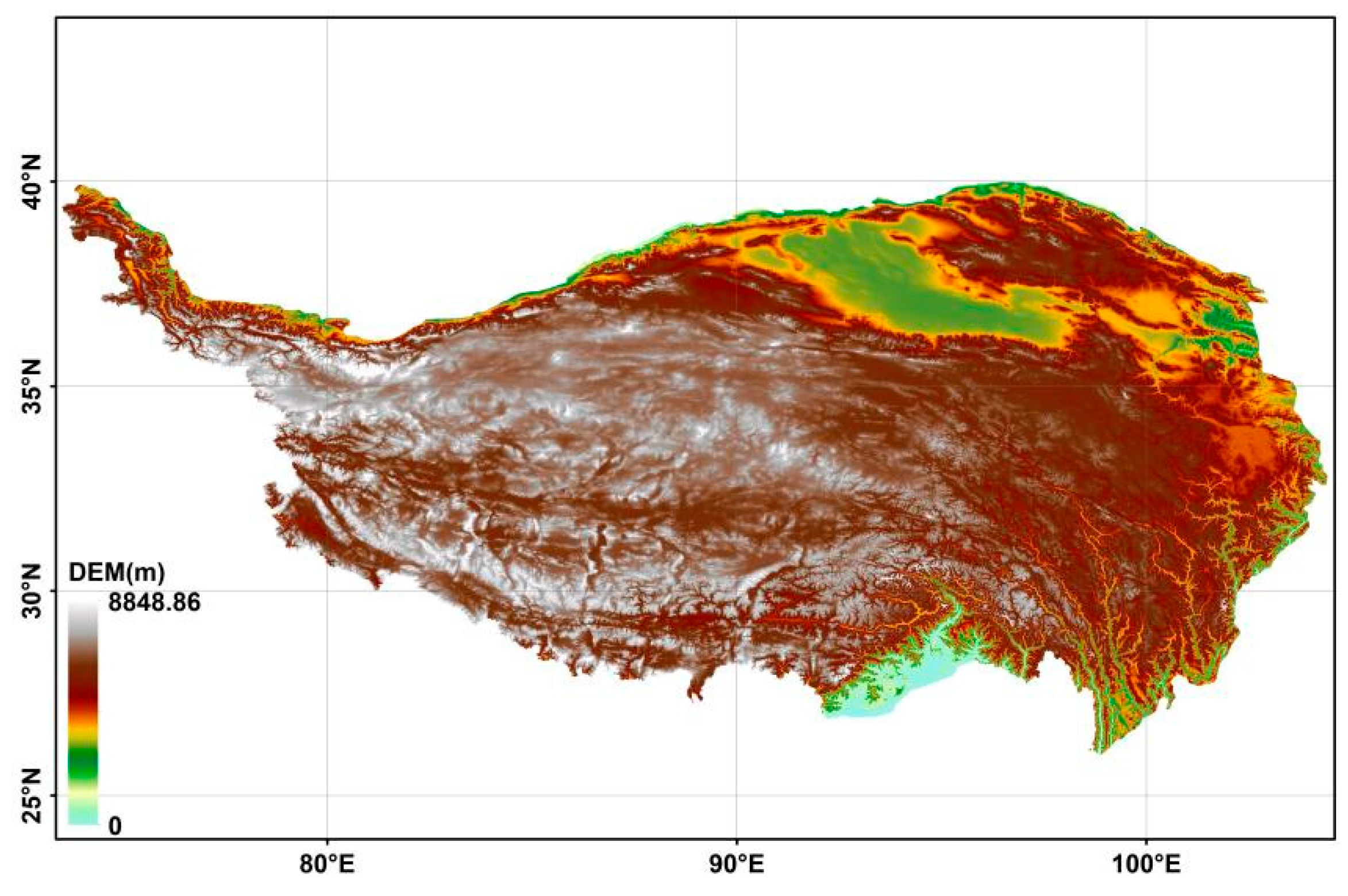
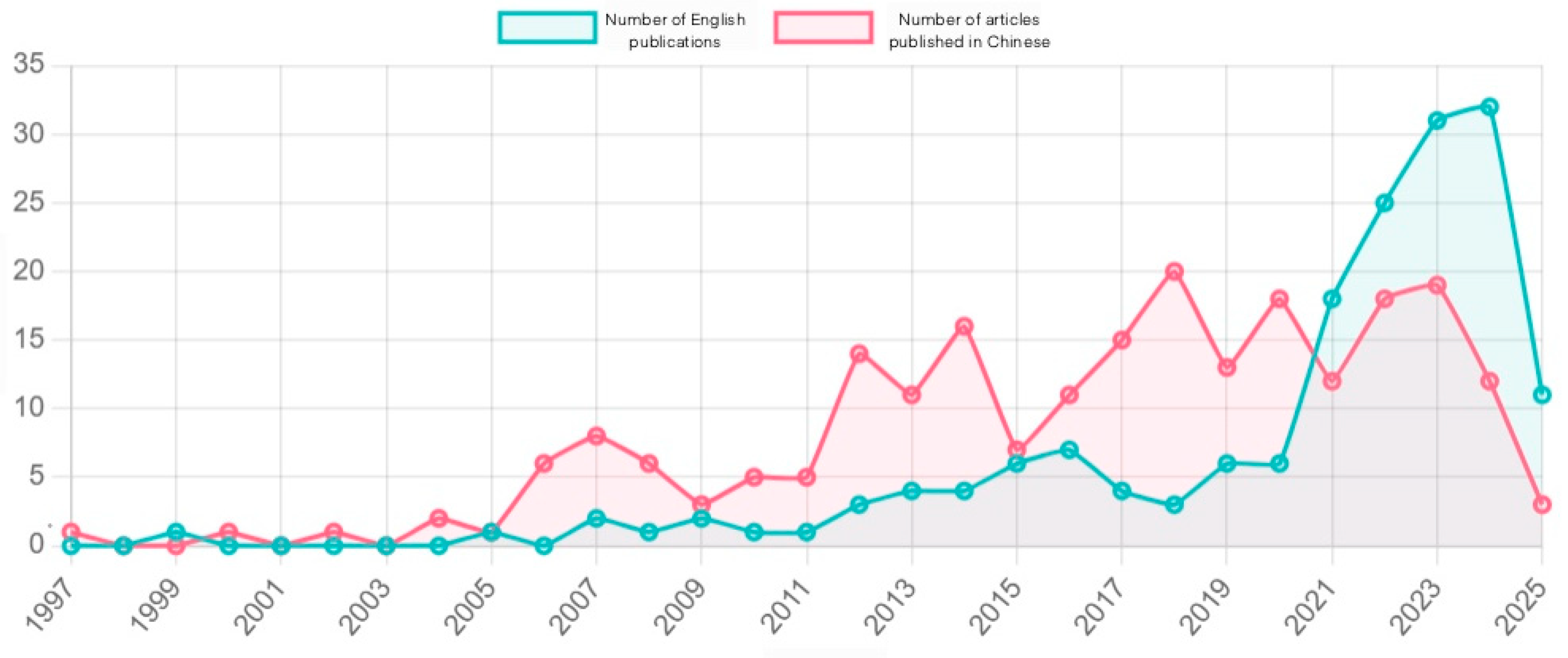
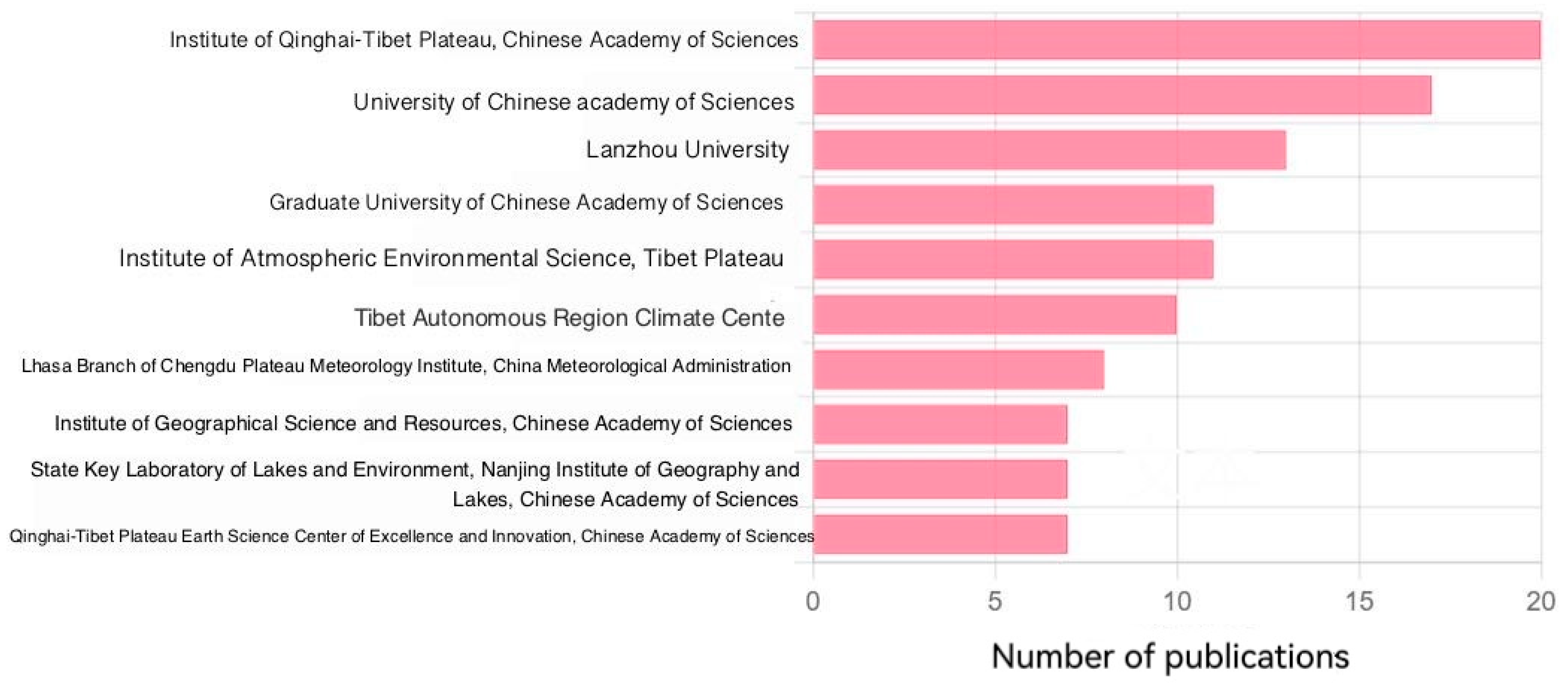
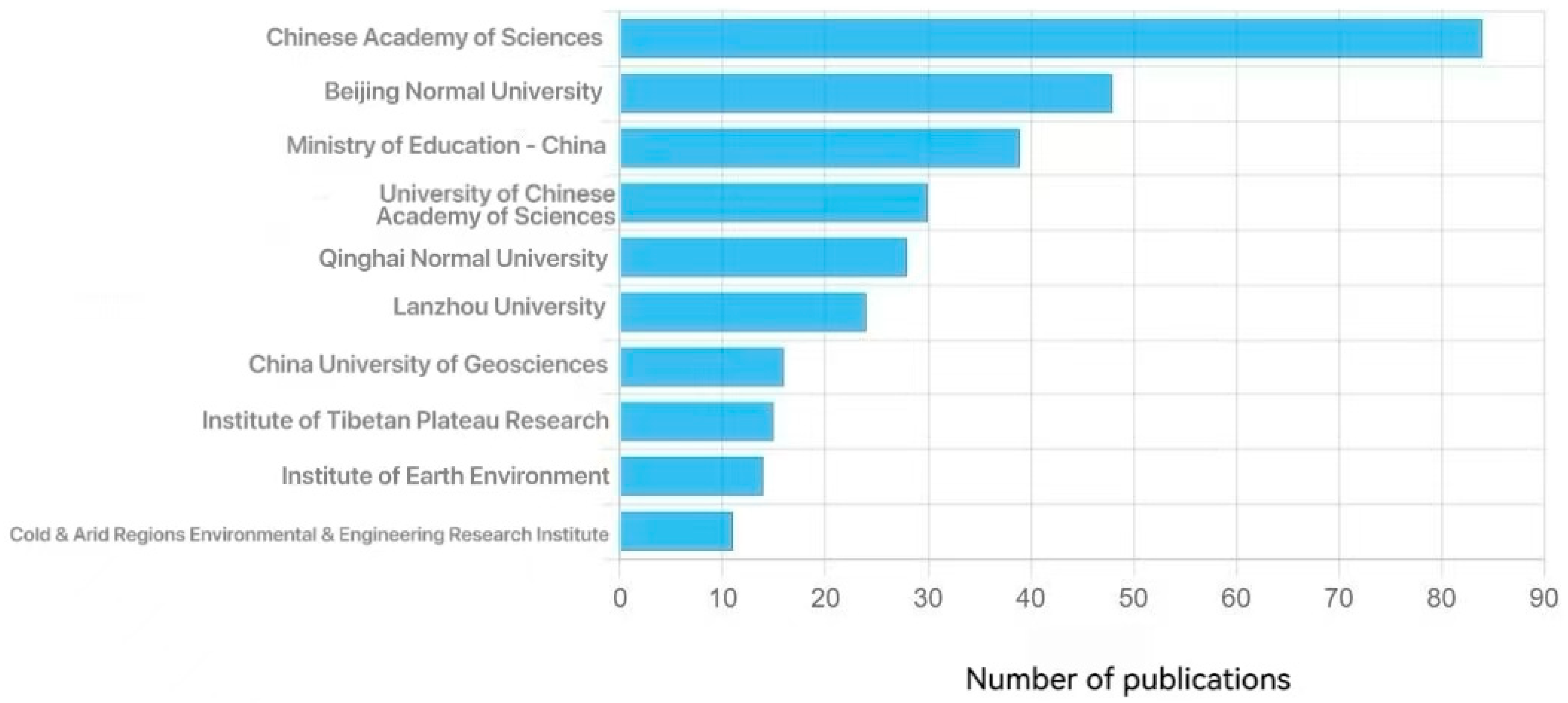
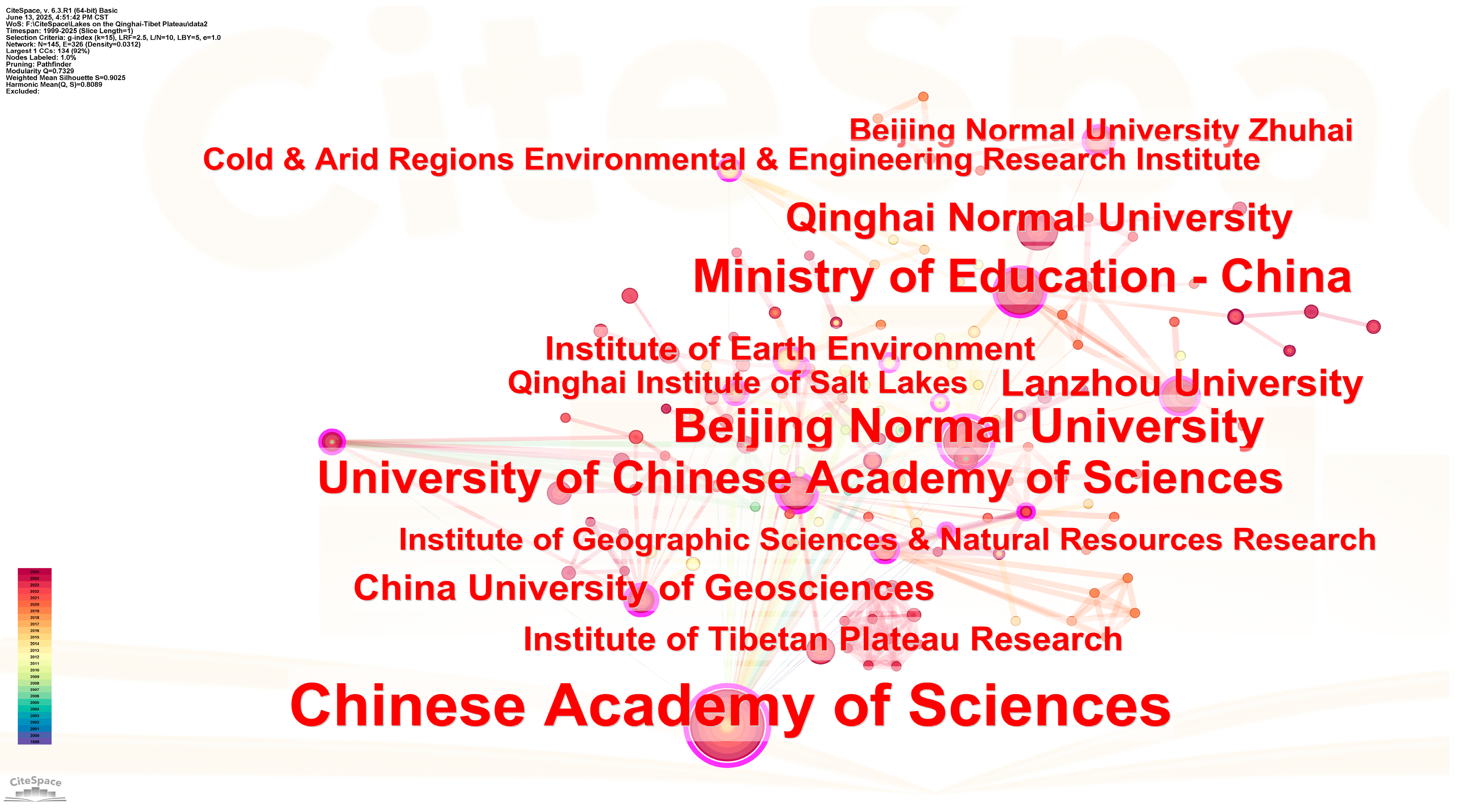
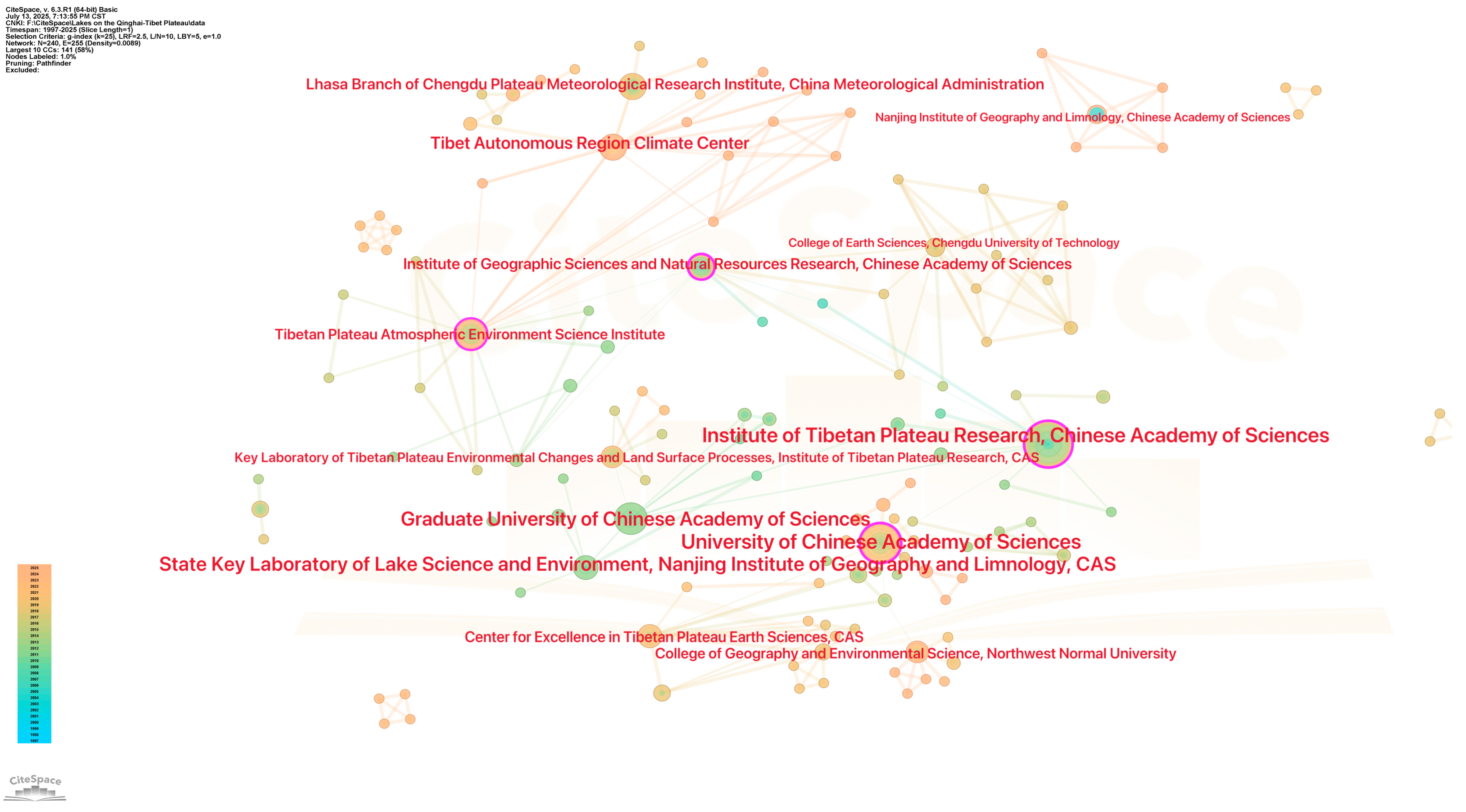
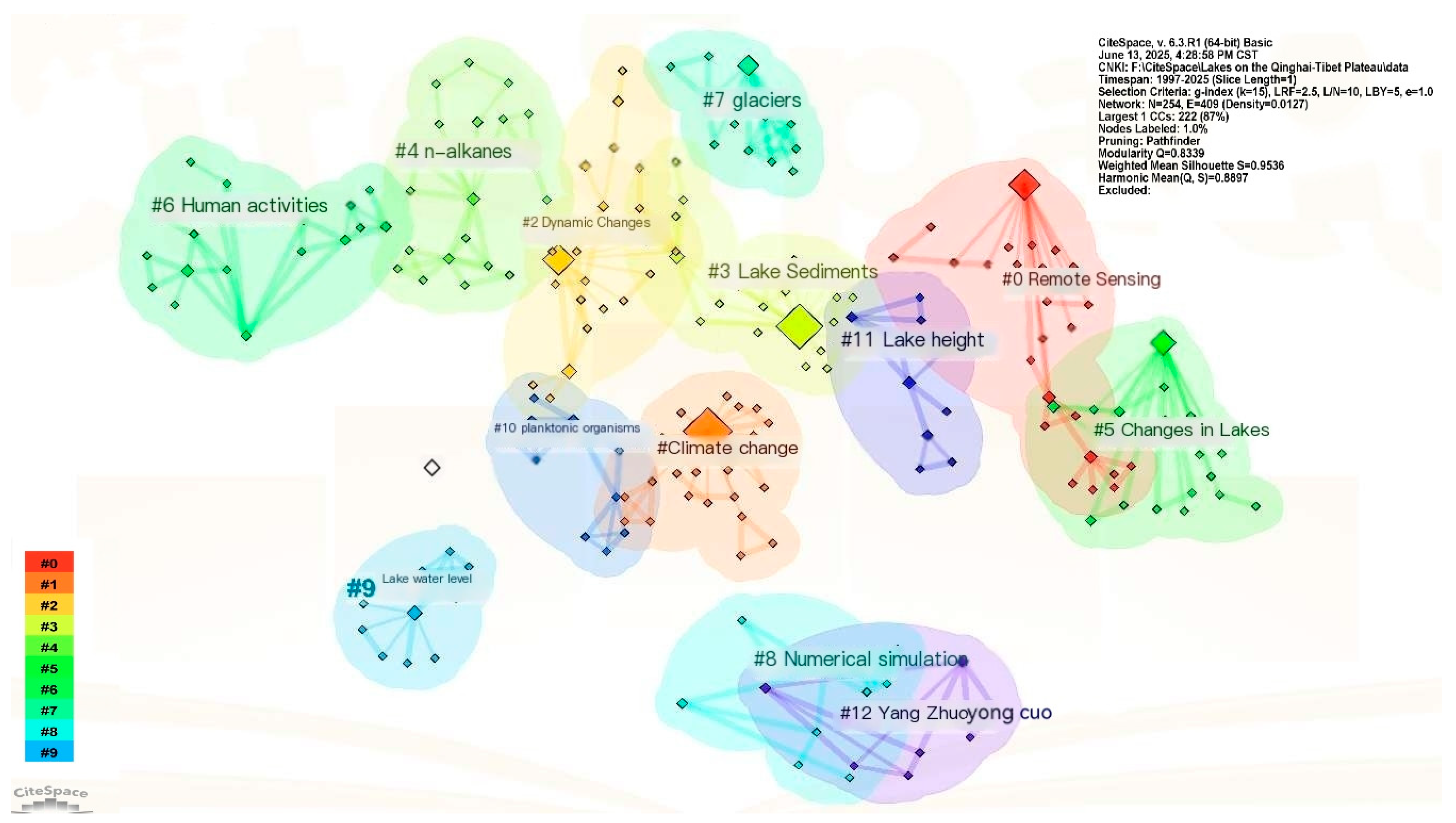
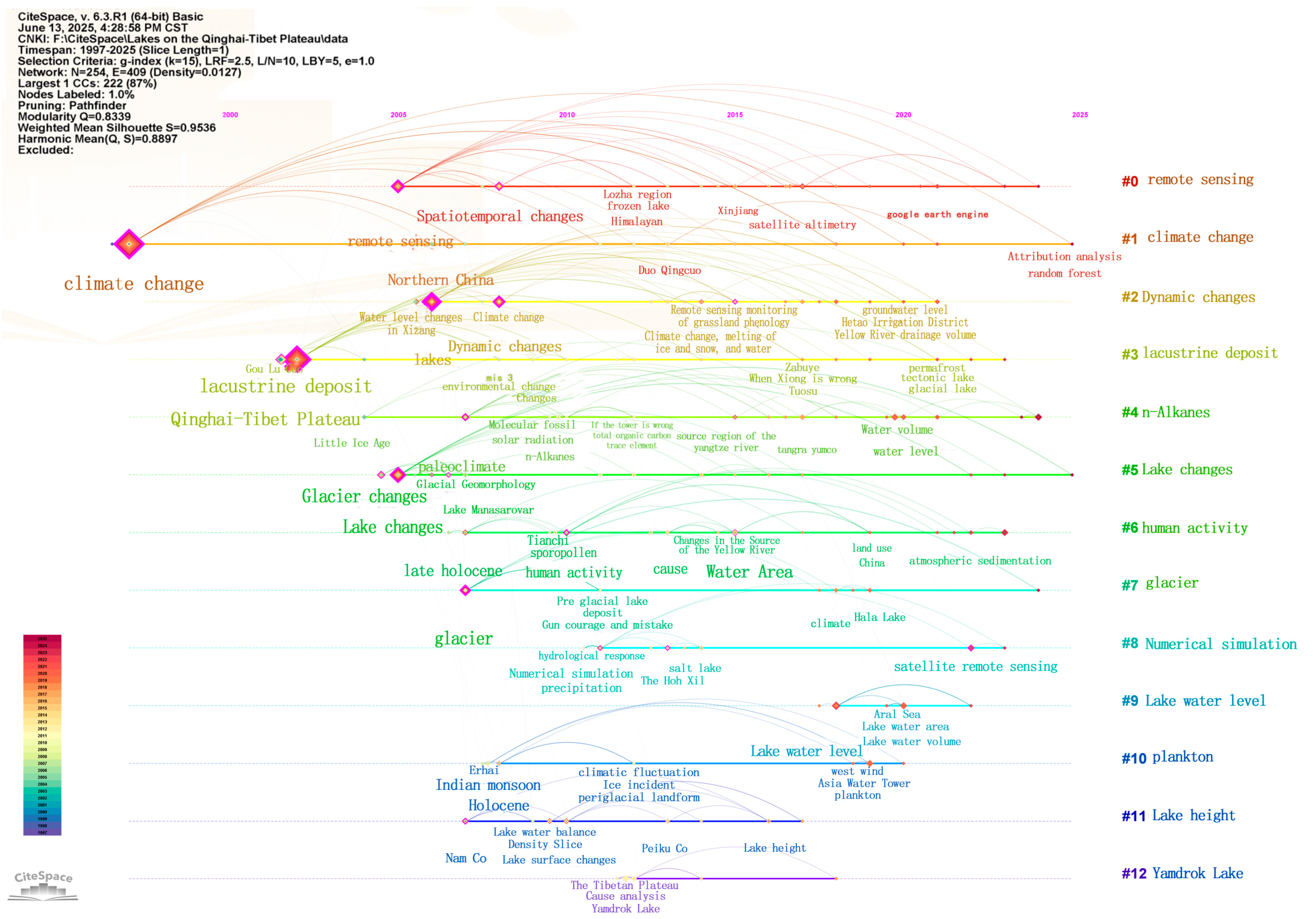
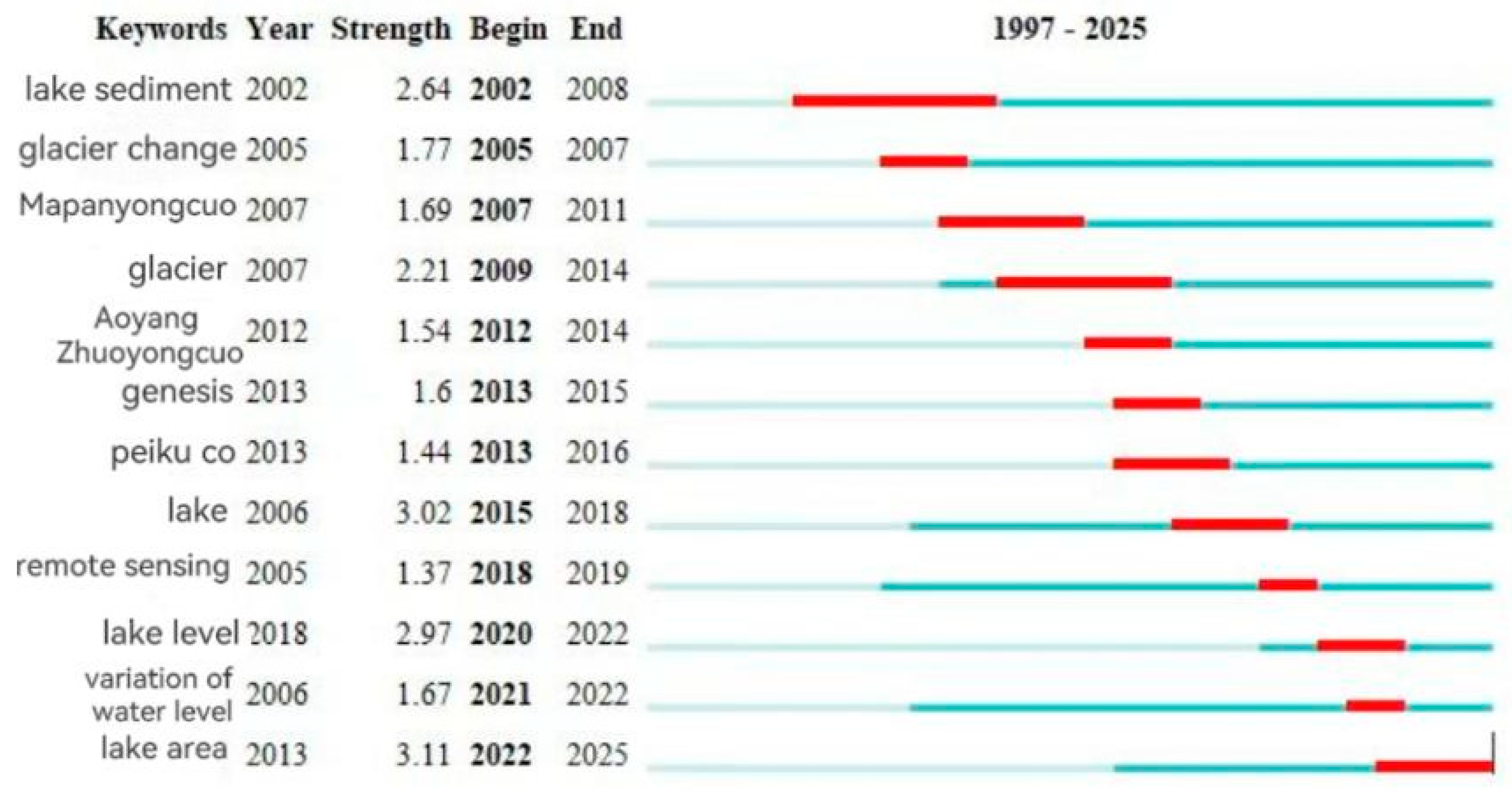

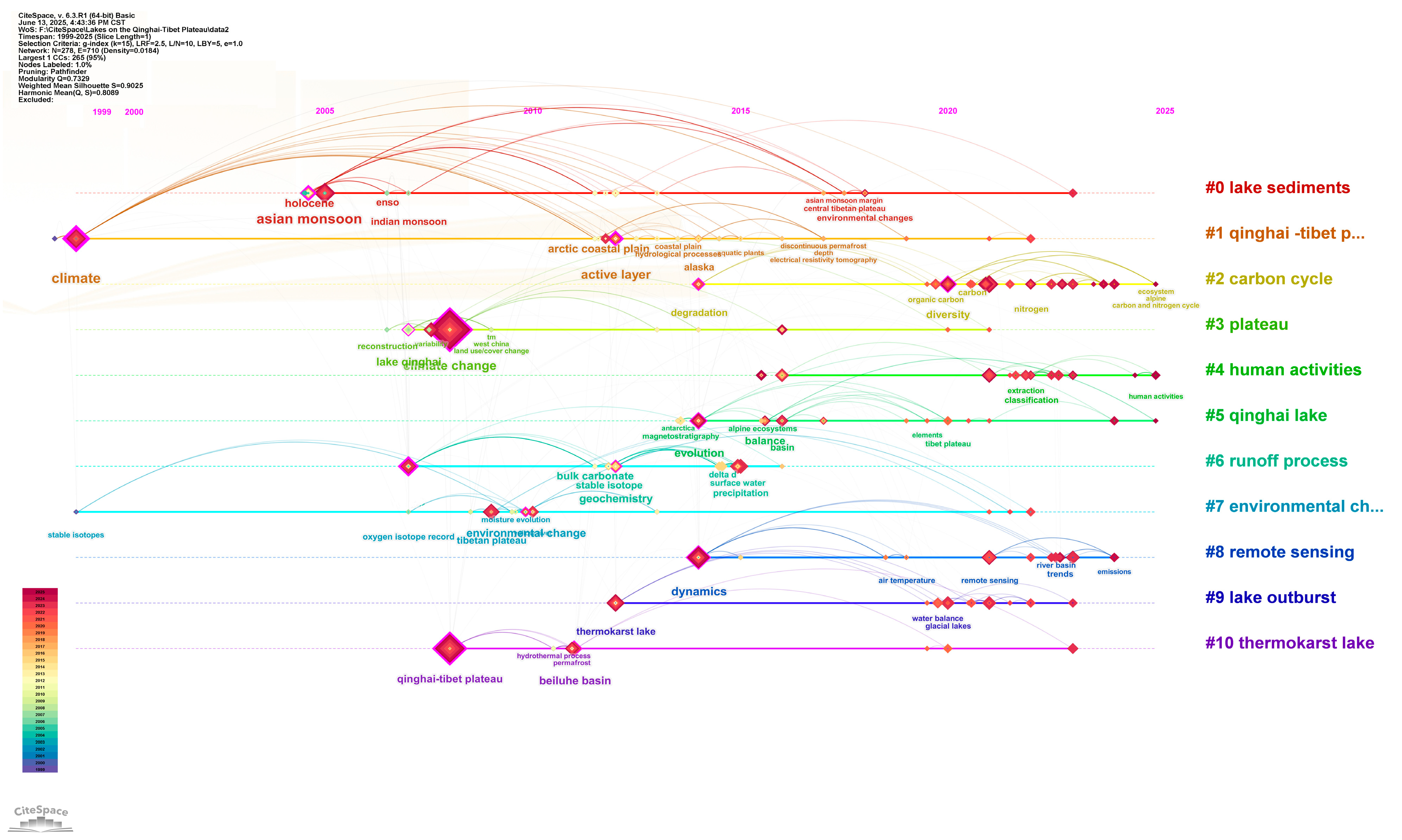
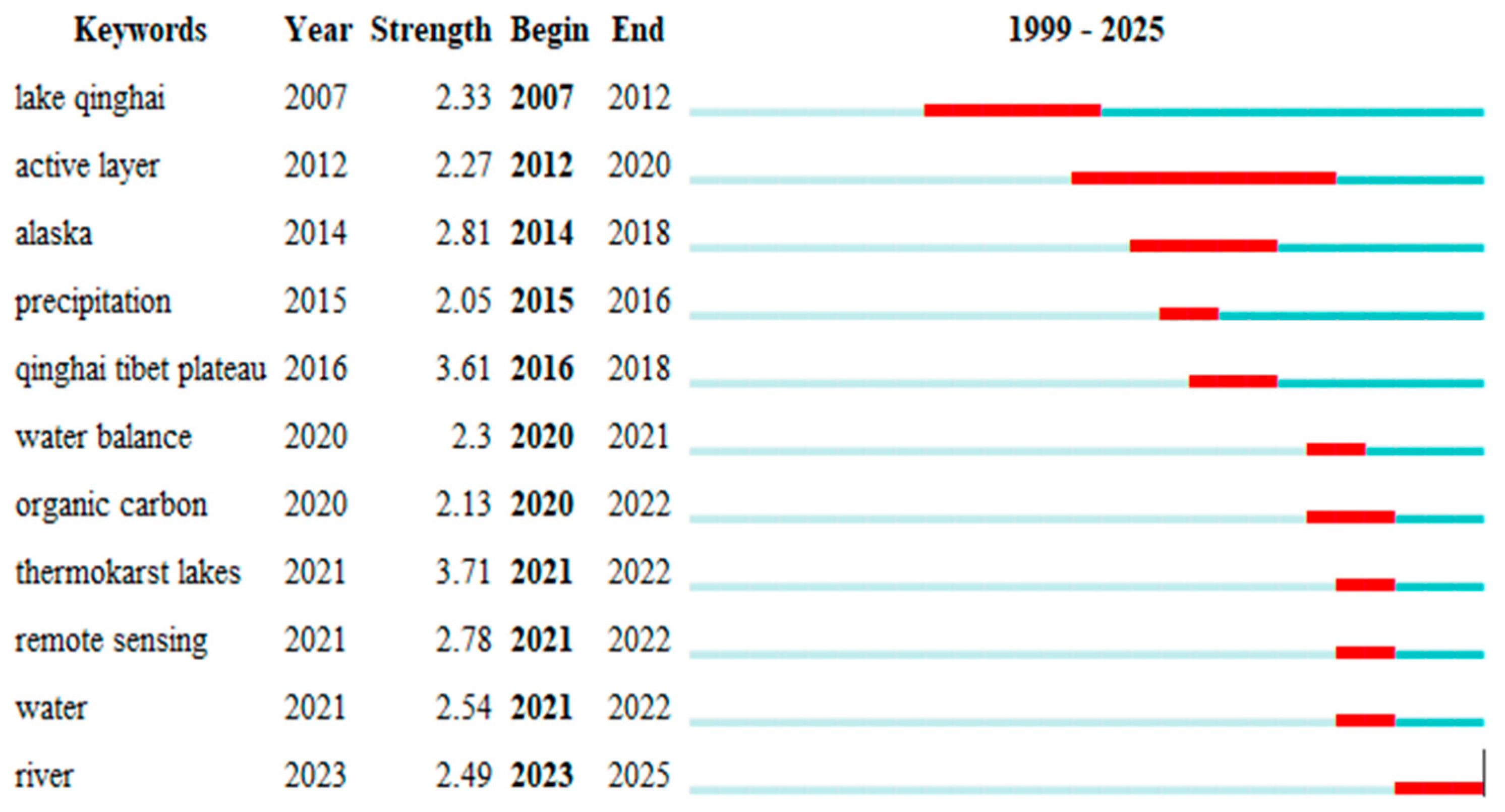

| Number of Publications | Betweenness Centrality | Earliest Year of Occurrence | Keyword |
|---|---|---|---|
| 103 | 0.43 | 1997 | Climatic change |
| 91 | 0.52 | 2002 | Tibetan plateau |
| 41 | 0.72 | 2006 | Lakes |
| 40 | 0.34 | 2005 | Remote sensing |
| 27 | 0.2 | 2005 | Lake change |
| 16 | 0.33 | 2007 | Glacier |
| 14 | 0.04 | 2013 | Lake area |
| 8 | 0.1 | 2002 | Lake sediments |
| 7 | 0.37 | 2008 | Dynamic changes |
| 7 | 0.07 | 2018 | Lake water level |
| Number of Publications | Betweenness Centrality | Earliest Year of Occurrence | Keyword |
|---|---|---|---|
| 80 | 0.53 | 2008 | Climate change |
| 44 | 0.15 | 2008 | Qinghai-tibet plateau |
| 27 | 0.34 | 1999 | Climate |
| 26 | 0.12 | 2014 | Dynamics |
| 19 | 0.12 | 2009 | Tibetan plateau |
| 19 | 0.22 | 2007 | China |
| 17 | 0.09 | 2016 | Basin |
| 15 | 0.05 | 2005 | Qinghai lake |
| 13 | 0.02 | 2021 | Water |
| 13 | 0.04 | 2012 | Thermokarst lake |
Disclaimer/Publisher’s Note: The statements, opinions and data contained in all publications are solely those of the individual author(s) and contributor(s) and not of MDPI and/or the editor(s). MDPI and/or the editor(s) disclaim responsibility for any injury to people or property resulting from any ideas, methods, instructions or products referred to in the content. |
© 2025 by the authors. Licensee MDPI, Basel, Switzerland. This article is an open access article distributed under the terms and conditions of the Creative Commons Attribution (CC BY) license (https://creativecommons.org/licenses/by/4.0/).
Share and Cite
Mei, X.; Yang, G.; Su, M.; Chen, T.; Yang, H.; Wang, L.; Rong, Y.; Zhao, C. Bibliometric Views on Lake Changes in the Qinghai-Tibet Plateau Under the Background of Climate Change. Water 2025, 17, 2429. https://doi.org/10.3390/w17162429
Mei X, Yang G, Su M, Chen T, Yang H, Wang L, Rong Y, Zhao C. Bibliometric Views on Lake Changes in the Qinghai-Tibet Plateau Under the Background of Climate Change. Water. 2025; 17(16):2429. https://doi.org/10.3390/w17162429
Chicago/Turabian StyleMei, Xingshuai, Guangyu Yang, Mengqing Su, Tongde Chen, Haizhen Yang, Lingling Wang, Yubo Rong, and Chunjing Zhao. 2025. "Bibliometric Views on Lake Changes in the Qinghai-Tibet Plateau Under the Background of Climate Change" Water 17, no. 16: 2429. https://doi.org/10.3390/w17162429
APA StyleMei, X., Yang, G., Su, M., Chen, T., Yang, H., Wang, L., Rong, Y., & Zhao, C. (2025). Bibliometric Views on Lake Changes in the Qinghai-Tibet Plateau Under the Background of Climate Change. Water, 17(16), 2429. https://doi.org/10.3390/w17162429







